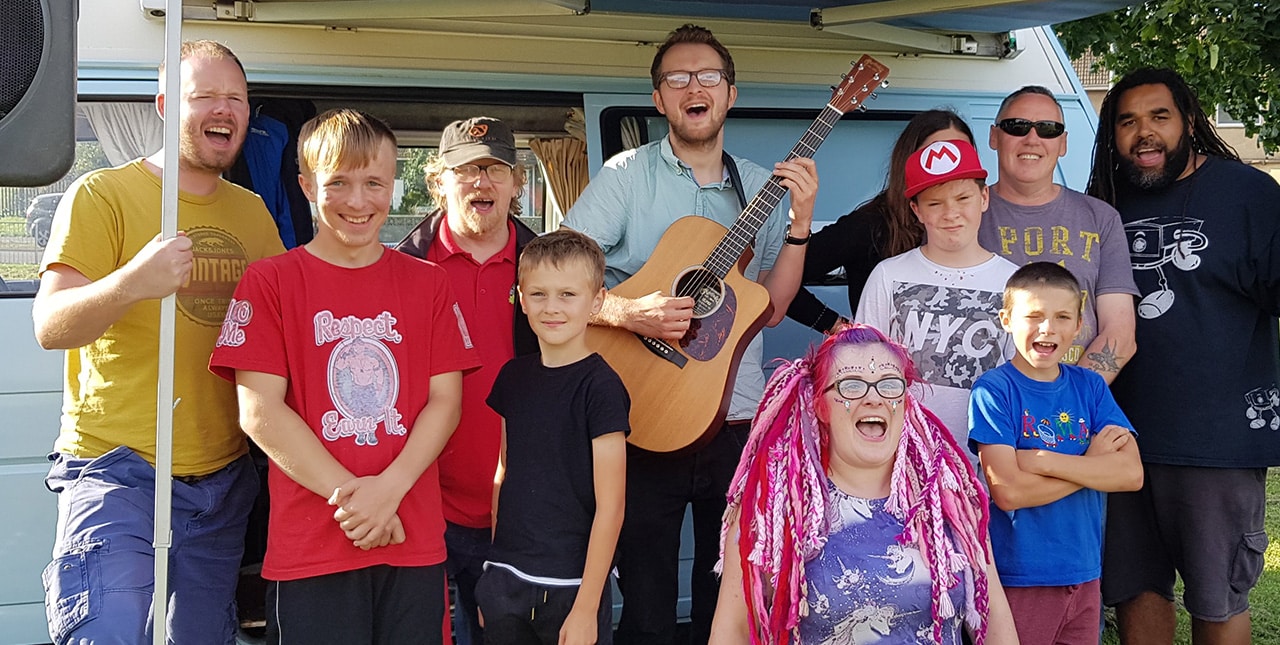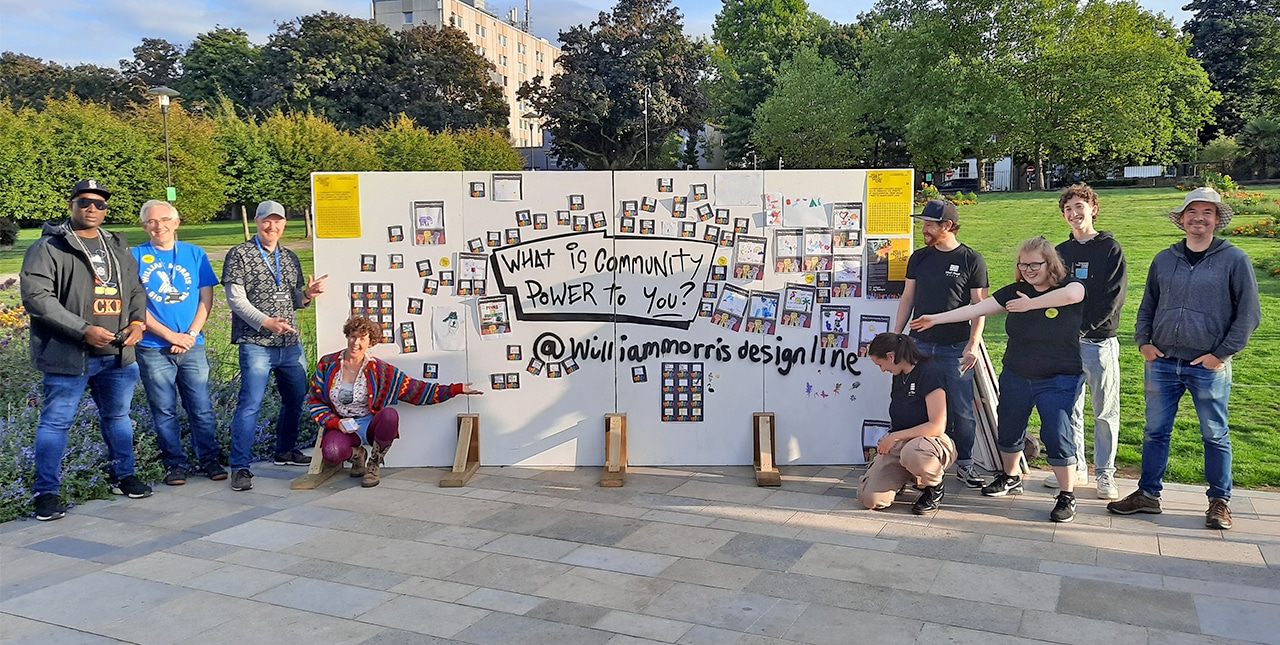How did Creative Civic Change grow community connections?
Creative Civic Change helped to grow many different types of connections between people and places:
- Between residents: 87% of respondents to our Communi-Tree survey said that they had met new people or felt more part of the community through Creative Civic Change activities.
- Between communities: “You know, I think the positive about the arts is creating links so much further afield as well. I mean, people [from] Manchester, Nottingham, Birmingham, Corby.” (Artist and working group member)
- Between artists: “There are brilliant artists working here … one of the things it’s really meant to us is that we have been able to connect because actually, as artists, we were quite fragmented.” (Artist)
- Between partners: “It’s a bit special. [Creative Civic Change] believe in what we do and how we do it. And we have an understanding, we are fiercely independent, but totally open to collaborative working, and they get it. There is a trust and an honesty in our conversations.” (Partner)
These increased connections formed the scaffolding of Creative Civic Change’s impact – holding the space for creativity, confidence, wellbeing and talent to flourish.

From Creative Civic Change project Creative Kingswood and Hazel Leys in Corby.
How did Creative Civic Change nourish creativity?
Using creativity for positive social change is the key driver of the Creative Civic Change programme. It is also one of the outcomes that people described. Creative Civic Change projects cultivated opportunities to:
- (Re)discover creativity: 89% of respondents to the Communi-Tree survey told us that Creative Civic Change activities gave them the opportunity to be creative or improved their personal creativity.
- Expand creativity: “I have pushed myself to try new ideas, the funding has allowed experimentation process.” (Artist)
- Value creativity: “I was a bit sceptical about using the arts to reach out to the wider community. In my wildest dreams, I never imagined that this was possible.” (Working group member)

From Creative Civic Change project Whitley Bay Carnival, Whitley Bay Big Local and Salto Arts in Whitley Bay in Northumberland.
How did Creative Civic Change foster confidence?
Creative Civic Change helped local residents, workers and creatives to grow their confidence to:
● Participate: “I’ve felt more confident to engage, and more positive about my creative skills and opinions.” (Communi-Tree survey respondent).
● Speak up: 81% of respondents told us that they felt heard by Creative Civic Change projects (Communi-Tree survey, 581 respondents).
● Lead: “I’ve grown in this group, I joined the group as a volunteer, and I ended up leading the group. I don’t know how that happened, but it did … it has nurtured me … it has transformed me from who I was to who I am today.” (Project worker)

From Creative Civic Change project, Hard Times Require Furious Dancing in Birmingham.
How did Creative Civic Change nurture wellbeing?
Creative Civic Change activities nurtured subjective wellbeing through connection and creativity:
- Sparking positive emotions: 97% of respondents to the Communi-Tree survey (787 respondents) experienced positive emotions during programme activities, especially happiness (64%).
- Supporting resilience: “You know, if you come in feeling low. When you go from here, you didn’t feel low anymore.” (Community member)
- Sowing hope: “It’s like, we’ve all just got loads of hope. We know that things can be achieved, and we work together.” (Artist and working group member)
It’s important to recognise the context that COVID-19 swept through communities while Creative Civic Change was being delivered, and this also had an impact on individuals’ wellbeing. Getting involved in creativity provided space, and moments of joy and connection, and arguably was even more important during a time that people couldn’t come together physically:
Doodling, painting, creating, can and does have an amazing effect on a person’s wellbeing and self-esteem.”
Artist

From Nudge Community Builders in Plymouth, Devon.
How did Creative Civic Change help to develop learning and skills?
Creative Civic Change activities provided a rich opportunity for community members, project workers, artists and partners to discover and develop:
- Community development skills: “It’s been probably one of the hardest things I’ve ever done in my professional career, this project, without a doubt. And I’ve learned so much about people, about myself and how I work and about what the organisation is and can be. It’s just been transformative really.” (Project worker)
- Creative skills: “It brought out the artist in a lot of people, a lot of people didn’t think they were artistic or [had] creative skills…one of them is me. Because of this group, I began to write poems again.” (Project lead)
- Artist development: Over 800 artists had the opportunity to work with Creative Civic Change communities, and 79% of them were locally based.

From Urban by Nature in London.
How did Creative Civic Change start to seed more positive attitudes towards communities?
Some, but not all, Creative Civic Change places talked about a shift in attitude towards their area, as external people (such as local media, local authorities, residents from other parts of the city, and arts organisations) began to think more positively about their community.
Many areas suffered from a poor reputation locally; they were seen as unsafe and anti-social, where nothing particularly good ever happened. The Creative Civic Change programme has started to slowly shift these perceptions. We think of this as a ‘new shoot’ of impact:
It’s really changed the reputation, I have friends who don’t live here and then they came and said it’s not how they thought it would be, it’s put [place] on the map, we’ve been in the paper, been on telly.”
Project worker
For one project, starting a social enterprise has started to build a bigger profile:
“I think also, there was a night where we did our first pigeon drop, and all of the pigeons sold out in just a few hours. And it was the same night that we launched our website. And for me it felt like the whole world could see the small neighbourhood because it was like, everywhere and there was just a real excitement … Someone told me that they felt like it was like getting a ticket to Glastonbury. It’s really rad.” (Project worker)
Projects described how they were now ‘on the map’ for positive reasons, for local people, for their local cultural sector, and amongst local authorities and other stakeholders:
“And then [art organisation and community organisation] want to come here. Yeah, they want to have their base here or around here … having the CCC money really has helped that.” (Project worker)
“We must be doing something right as there’s people in the council now who want to follow our lead…lots of people want to know what’s happening here now, I’ve had five or six areas contacting me about the market saying ‘we want to do one’.” (Community member)
Further reading
Hannah Slogget, project lead at Nudge Community Builders in Plymouth, talks about the effect of Creative Civic Change on their neighbourhood.
Jessica Holmes reflects on how the Creative West End project in Morecambe helped her small business.

